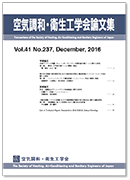
- |<
- <
- 1
- >
- >|
-
Part 1-Outlines of a Performance Prediction Tool and its ValidationTakao KATSURA, Takashi YAMAGUCHI2016 Volume 41 Issue 237 Pages 1-10
Published: December 05, 2016
Released on J-STAGE: December 05, 2017
JOURNAL FREE ACCESSThese studies aim at developing a performance prediction tool for a heat pump system taking the refrigeration cycle into consideration. This paper constitutes Part 1 in this series of studies. In this paper, it is indicated that the physics model of a heat pump system can be simplified on the basis of the calculation equation of the compressor. The authors simplified the physics model's calculation and developed an annual performance prediction tool for the heat pump system taking the refrigeration cycle into consideration. In this design tool, the calculated condition can be obtained by using the heat pump system's specification form and the annual performance can be calculated with high speed. In addition, it is possible to change a part of the equipment constituting the heat pump system such as the evaporator, condenser, and compressor. This tool can also perform calculation for the heat pump system with the control that the refrigerant's evaporating or condensing temperature is kept constant. The energy consumption of the water source variant refrigerant flow heat pump system installed in the office building was calculated by using the tool and compared to the measured consumption. The results showed that the relative errors between the calculated energy consumption and the measured consumption are 1.0% for the summer and 4.8% for the winter, respectively. Therefore, it is confirmed that the developed tool can predict the annual performance of the heat pump air conditioning system with acceptable precision.
View full abstractDownload PDF (1356K) -
Part 3-Proposal and Verification of a Simulation Method for Identifying the Performance of Carrying Toilet Paper in Horizontal Drain PipesHiroshi SHIGEFUJI, Masayuki OTSUKA, Kazuya AKIYAMA, Takafumi MATSUO2016 Volume 41 Issue 237 Pages 11-21
Published: December 05, 2016
Released on J-STAGE: December 05, 2017
JOURNAL FREE ACCESSThe study proposes a simulation method for identifying fixture discharge characteristics of water-saving toilets, when the toilets are connected to horizontal drainpipes in various configurations, and for predicting the carrying performance in the horizontal drainpipes, using realistic waste. The study also verifies the effectiveness of the simulation method. In the previous report, a JIS-approved water-saving toilet was connected to various piping configurations, and a calculation model was proposed, with which the waste carrying performance was calculated on the basis of the magnitude of the carrying force, which was calculated from the fixture discharge characteristic values when the toilet was flushed with clean water, and the magnitude of friction generated with an artificial waste substitute. The previous report also examined the effectiveness of the model. This report focuses on the actual use of toilet paper and adds to the previous calculation model the pressure (to push the toilet paper) due to the drained water during a pipe blockage caused by toilet paper, in order to develop a new calculation method for predicting the performance (the distance) of carrying toilet paper having a complicated shape, as well as examining the appropriateness of the method.
View full abstractDownload PDF (1731K)
-
-Simulations of Air Conditioning Duct Performance Using CFD Analysis-Toshihiko SUDO, Ryoichi KAJIYA2016 Volume 41 Issue 237 Pages 23-30
Published: December 05, 2016
Released on J-STAGE: December 05, 2017
JOURNAL FREE ACCESSThe integration of two technologies –air conditioning duct systems and optical mirror duct systems– into a new energy-saving system called the Integrated Optical Air Duct System (IOAD) significantly reduces the lighting energy consumption, which accounts for roughly 30% of the energy consumption in large-scale office buildings. The utilization of IOAD in combination with other energy reduction techniques could help these office buildings become Zero Energy Buildings (ZEB). The IOAD System could minimize the effect of natural light loss during light transport inside the air conditioning duct branches and thus allow for the efficient usage of daylight. Computational fluid dynamics (CFD) simulations were performed to examine the flow of conditioned air in the duct.
View full abstractDownload PDF (2433K) -
Disaster Preparedness Center in a Medium-Sized Office Building with a Photovoltaic Generation SystemPart 2-Quantitative Evaluation of Electric Power Self-reliance During an EmergencyYoshiki YONEYAMA, Toyohiro NISHIKAWA2016 Volume 41 Issue 237 Pages 31-37
Published: December 05, 2016
Released on J-STAGE: December 05, 2017
JOURNAL FREE ACCESSThe establishment of a social system that is resilient to disasters and environmentally conscious is a pressing requirement since the occurrence of the Great East Japan Earthquake. This study deals with the evaluation of the energy-saving, self-supporting power supply of a photovoltaic generation system (with a storage battery) in a medium-sized office building located in Miyako city, Iwate Prefecture. In a previous study, the reduction in required power was evaluated and general power consumption characteristics were determined using electric power consumption data. In addition, photovoltaic power generation was measured annually. In this study, the power consumption required in an emergency is estimated from the relationship between the power generation and outside air temperature using the measured data. Therefore, the functionality of the disaster prevention center can be gauged by calculating the electric power self-support rate over three days (72 h) after a disaster.
View full abstractDownload PDF (798K)
- |<
- <
- 1
- >
- >|